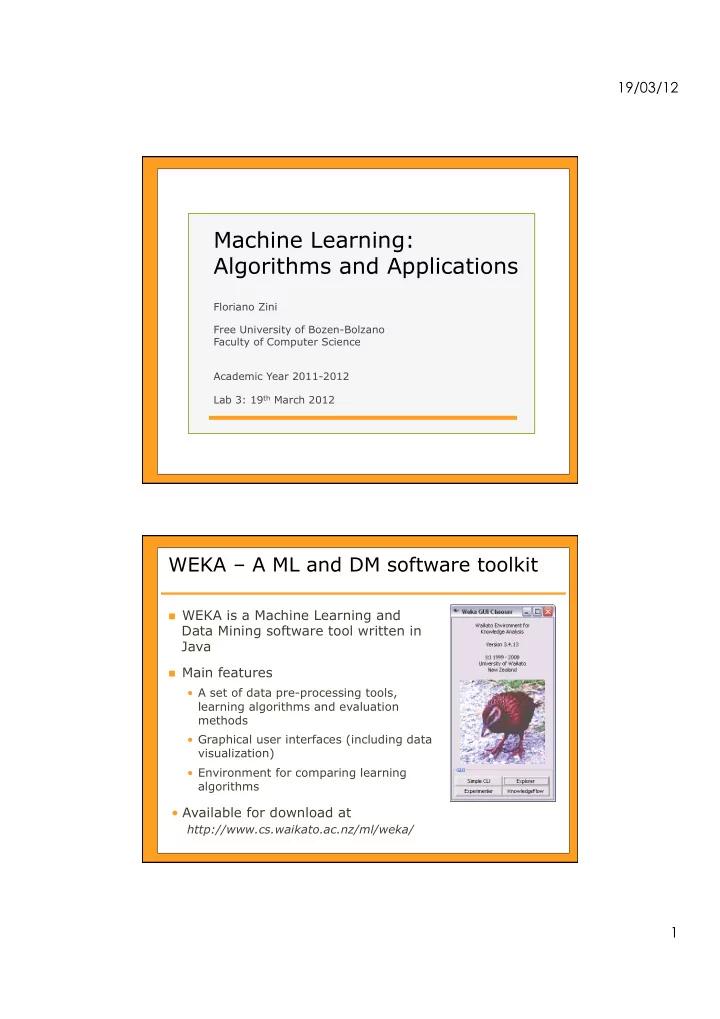

19/03/12 Machine Learning: Algorithms and Applications Floriano Zini Free University of Bozen-Bolzano Faculty of Computer Science Academic Year 2011-2012 Lab 3: 19 th March 2012 WEKA – A ML and DM software toolkit n WEKA is a Machine Learning and Data Mining software tool written in Java n Main features • A set of data pre-processing tools, learning algorithms and evaluation methods • Graphical user interfaces (including data visualization) • Environment for comparing learning algorithms • Available for download at http://www.cs.waikato.ac.nz/ml/weka/ 1
19/03/12 WEKA – Main environments Simple CLI A simple command-line interface Explorer (we will use this environment!) An environment for exploring data with WEKA Experimenter An environment for performing experiments and conducting statistical tests between learning schemes KnowledgeFlow An environment that allows you to graphically (drag-and- drop) design the flows of an experiment WEKA – The Explorer environment 2
19/03/12 WEKA – The Explorer environment Preprocess To choose and modify the data being acted on Classify To train and test learning schemes that classify or perform regression Cluster To learn clusters for the data Associate To discover association rules from the data Select attributes To determine and select the most relevant attributes in the data Visualize To view an interactive 2D plot of the data WEKA – The dataset format WEKA deals only with flat (text) files in ARFF (Attribute Relationship File Format) Example of a dataset Name of the @relation weather dataset @attribute outlook {sunny, overcast, rainy} Nominal attribute @attribute temperature real Numeric @attribute humidity real attribute @attribute windy {TRUE, FALSE} @attribute play {yes, no} Classification (i.e., by default, the last @data defined attribute) sunny,85,85,FALSE,no overcast,83,86,FALSE,yes The … examples (instances) 3
19/03/12 WEKA Explorer: Data pre-processing Data can be imported from a file in formats: ARFF, CSV, binary Data can also be read from a URL or from an SQL database using JDBC Pre-processing tools in WEKA are called filters • Discretization • Normalization • Re-sampling • Attribute selection • Transforming and combining attributes • … WEKA Explorer: Classifiers (1) Classifiers in WEKA are models for predicting nominal or numeric quantities Classification techniques implemented in WEKA • Naïve Bayes classifier and Bayesian networks • Decision trees • Instance-based classifiers • Support vector machines • Neural networks • Linear regression • … 4
19/03/12 WEKA Explorer: Classifiers (2) Select a classifier Select test options • Use training set . The learned classifier will be evaluated on the training set • Supplied test set . To use a different dataset for the evaluation • Cross-validation . The dataset is divided in a number of folds, and the learned classifier is evaluated by cross- validation • Percentage split . To indicate the percentage of the dataset held out for the evaluation WEKA Explorer: Classifiers (3) More options… • Output model . To output (display) the learned classifier • Output per-class stats . To output the precision/recall and true/ false statistics for each class • Output entropy evaluation measures . To output the entropy evaluation measures • Output confusion matrix . To output the confusion (classification- error) matrix of the classifier ’ s predictions • Store predictions for visualization . The classifier’s predictions are saved in the memory so that they can be visualized later • Output predictions . To output the predictions on the test set • Random seed for XVal / % Split . To specify the random seed used when randomizing the data before it is divided up for evaluation purposes 5
19/03/12 WEKA Explorer: Classifiers (4) Classifier output shows important information • Run information . The learning scheme options, name of the dataset, instances, attributes, and test mode • Classifier model (full training set) . A textual representation of the classifier learned on the full training data • Predictions on test data . The learned classifier’s predictions on the test set • Summary . The statistics on how accurately the classifier predicts the true class of the instances under the chosen test mode • Detailed Accuracy By Class . A more detailed per-class break down of the classifier ’ s prediction accuracy • Confusion Matrix . Elements show the number of test examples whose actual class is the row and whose predicted class is the column WEKA Explorer: Classifiers (5) Result list provides some useful functions • Save model . Saves a model (i.e., a trained classifier) object to a binary file. Objects are saved in Java ‘ serialized object ’ form • Load model . Loads a pre-trained model (i.e., a previously learned classifier) object from a binary file • Re-evaluate model on current test set . To evaluate a previously learned classifier on the current test set • Visualize classifier errors . To show a visualization window that plots the results of classification Correctly classified instances are represented by crosses, whereas incorrectly classified ones show up as squares • … 6
19/03/12 WEKA Explorer: Attribute selection To identify which (subsets of) attributes are the most predictive ones In WEKA, a method for attribute selection consists of two parts • “ Attribute Evaluator ”. An evaluation method for evaluating the appropriateness of attributes correlation-based, wrapper, information gain, chi-squared, … • “ Search Method ”. A search method for determining how (in which order) the attributes are examined best-first, random, exhaustive, ranking,… WEKA Explorer: Data visualization Visualization is very useful in practice helps to determine difficulty of the learning problem WEKA can visualize • a single attribute (1-D visualization) • a pair of attributes (2-D visualization) Different class values (labels) are visualized in different colors Jitter slider supports better visualization when many instances locate (concentrate) around a point in the plot Zooming in/out (i.e., by increasing/decreasing PlotSize and PointSize) 7
Recommend
More recommend